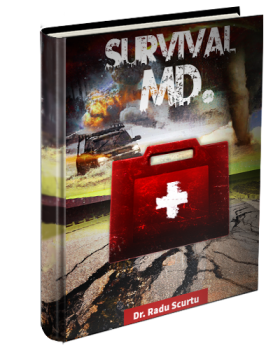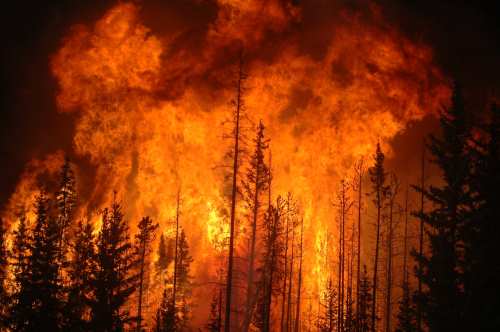No matter how hard you try to prevent it, it’s going to happen. At some point someone is going to get burnt and there will be no doctor to attend them post SHTF. Some burns will be severe and there will be nothing you can do about them. For those you can offer first aid for, advice is given below.
Chemical Burns
It’s vital to keep chemicals in their original containers, the label will have advice on what to do should the chemical get onto the skin. Some chemicals should not be mixed with water, some should be rinsed off etc so knowing what you are dealing with is vital and can prevent permanent injury or in some cases death.
- Wearing protective gloves, remove any chemicals from the skin by running the affected area under cool tap water for 20 minutes, or more.
- If the chemical involved is in powder form, such as lime, brush it off the skin before running the skin under water.
- Remove any jewellery, or clothing, that may have been exposed to the chemical.
- Apply a cool wet towel to help relieve pain, if safe to do so.
- Cover the burnt skin with a dry, sterile dressing, or clean cloth.
- If you experience an increased sensation of burning, rewash the skin for several more minutes.
Electrical Burns
Electrical burns can come from those people stuck by lightening or from exposure to mains electrify and in either of those cases there is little you can do. Less severe but still damaging electrical burns can come from any devise that stores energy, batteries for example. These burns are to be taken seriously even if they look pretty minor. The discharge of electricity if strong enough to burn the skin is strong enough to cause deeper tissue damage.
A word of caution about microwaves. DO NOT be tempted to scavenge bits from the circuits etc. Even  when switched off and unplugged they retain enough electrical energy not only to burn but to kill outright. Taking the back off is quite literally dicing with death unless you really know what you’re doing and even most electricians would not take the risk.
when switched off and unplugged they retain enough electrical energy not only to burn but to kill outright. Taking the back off is quite literally dicing with death unless you really know what you’re doing and even most electricians would not take the risk.
Lightening strikes are considered to be electrical burns. Often there will be little to see but massive internal damage often results. If the person survives the strike there will be no way of knowing the internal damage that has been sustained. There can sometimes be a slow breakdown of one or more internal organs after the event. Other people have impairment to a given limb, or memory loss after a lightening strike. Personality change is not uncommon. The burns should be kept clean and covered with a dry dressing as should any type of electrical burn.
Radiation Burns
If you’ve ever been sun burnt you have had a radiation burn. Radiation burns are painful in the extreme. How severe the burn is depends on the exposure. Wrap in cool damp clothes that are changed frequently. Natural yogurt takes the heat out of sunburn very effectively. Radiation burns are also possible if you have been exposed to fallout from a thermo-nuclear device.
Having a radiation burn means the body has been exposed to ionizing radiation but unless the expose time and dose is known it’s impossible to say if the internal organs have been affected and if death will follow.
Not all exposure to nuclear radiation kills, and a short burst reddening the skin is much less dangerous than a long drawn out low level exposure such as that experienced after Chernobyl or the ongoing situation with Fukushima.
Contact Burns
Contact burns as the name suggests results in coming into contact with something hot. This could be any number of things, a spark from the fire, a pan handle or contact with a hundred and one other things. Scalds from boiling liquids can also be considered contact burns, as can steam burns.
- Immediately get the person away from the heat source to stop the burning.
- Cool the burn with cool or lukewarm water for 10-30 minutes minimum, longer if the pain returns within a minute or so of removing it from the water. Do not use ice, iced water or any creams or greasy substances, such as butter.
- Remove any clothing or jewellery that is near the burnt area of skin, but do not move anything that is stuck to the skin
- Make sure the person keeps warm – for example by using a blanket – but take care not to rub it against the burnt area.
- Cover the burn by placing a layer of cling film over it. Plastic bags are idea for burns on the hands or feet.
- Give pain relief such as paracetamol (acetaminophen) or ibuprofen. Children under 16 should never be given aspirin though it’s fine for adults.
- Do not interfere with the burn or break any blisters even if the burn is very painful or appears to be getting worse.
First, second and third degree burns
- First-degree burns affect only the outer layer of the skin. They cause pain, redness, and swelling.
- Second-degree (partial thickness) burns affect both the outer and underlying layer of skin. They cause pain, redness, swelling, and blistering.
- Third-degree (full thickness) burns extend into deeper tissues. They cause white or blackened, charred skin that may be numb.
Symptoms
- Blisters
- Pain (the degree of pain is not related to the severity of the burn — the most serious burns can be painless as nerves are destroyed)
- Peeling skin
- Red skin
- Shock (watch for pale and clammy skin, weakness, bluish lips and fingernails, and a drop in alertness)
- Swelling
- White or charred skin
Children under age 4 and adults over age 60 have a higher chance of complications and death from severe burns.
The main danger from severe burns is dehydration due to loss of fluids, and colonization with pseudomonas, and aggressive form of bacteria that flourish in the moist open environment provided by burnt skin.
Be aware that severe burns smell, even before any infection sets in severe burns smell and it’s the kind of smell you will never forget. In any kind of very severe burn you will only be able to offer palliative care and this should be concentrated on making the patient as comfortable as possible.
Care should also be taken to make sure that full barrier nursing is employed,gloves and some kind of gown or apron at a minimum. Pseudomonal infection is opportunist and is as happy infecting any cuts or grazes you have as it would be infecting a burns victim.
Airway Burns
The airways can be burnt due to the inhalation of smoke or other hot gases.
Symptoms of an airways burn:
- Charred mouth; burned lips
- Burns on the head, face, or neck
- Wheezing
- Change in voice
- Difficulty breathing; coughing
- Singed nose hairs or eyebrows
- Dark, carbon-stained mucus
Airway burns are survivable but the chances of survival depend entirely on the amount of lung damage which in turn depends on the temperature of the smoke that has been inhaled. Severe impairment of gas exchange due to damaged airways will usually result in death either immediately or very shortly after the fire.
Should the victim survive there is no way of predicting how much damage there has been and what the medium to long term effects will be outside of a hospital environment.
Take Care
Liz
Originally published at undergroundmedic.com
Other useful resources:
Survival MD (Best Post SHTF Medical Survival Guide Ever)
Blackout USA (EMP survival and preparedness guide)
Backyard Innovator (All Year Round Source Of Fresh Meat,Vegetables And Clean Drinking Water)
Conquering the coming collapse (Financial advice and preparedness )
Liberty Generator (Easy DIY to build your own off-grid free energy device)
Backyard Liberty (Easy and cheap DIY Aquaponic system to grow your organic and living food bank)
Bullet Proof Home (A Prepper’s Guide in Safeguarding a Home )
Family Self Defense (Best Self Defense Strategies For You And Your Family)
Sold Out After Crisis (Best 37 Items To Hoard For A Long Term Crisis)

